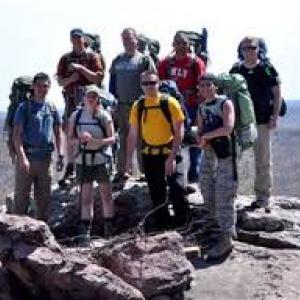 Jenna Caplette migrated from California to Montana in the early 1970s, first living on the Crow Indian reservation, then moving to Bozeman where she owned a downtown retail anchor for eighteen years. These days she owns Bozeman BodyTalk & Energetic Healthcare, hosts a monthly movie night, teaches and writes about many topics.
Jenna Caplette migrated from California to Montana in the early 1970s, first living on the Crow Indian reservation, then moving to Bozeman where she owned a downtown retail anchor for eighteen years. These days she owns Bozeman BodyTalk & Energetic Healthcare, hosts a monthly movie night, teaches and writes about many topics.
While out hiking recently, twice I’ve been asked to use someone’s iPhone to snap a group photo (Well, okay. One time I offered). Both times I wanted to take a good, memorable photo, capture the group’s delight in being with each other, but wasn’t sure how to achieve that with an iPhone (or even an unfamiliar point and shoot if I’m handed one).
So I asked folks at F-11 Photographic Supplies for some basic tips for helpful things to say and do when you ask someone to take your group photo while on your next outing.
First, it’s self-evident that these types of photos are posed. That in itself creates a challenge. Ask people to hold still and smile while you fiddle with getting everything just right with a camera and their smile disappears just as you snap the shutter. Become familiar with whatever camera you are using before you start. Spontaneity makes great photos. If you talk with them, or ask them to interact with each other, you‘re likely to do much better. Watch for the right moment and the next right moment. Photograph them all. Remember. It’s just pixels. You can afford to be extravagant.
Take a couple moments to check the background of the shot. It can be a distraction, or a feature if you’re being asked to incorporate a particular mountain/tree/landmark/monument. Be careful. A photo of a child with a tree sticking out the top of their head is memorable but probably not in the way you want. Bright lights in the background, particularly when your subjects are standing in subdued light or shade, can also be distracting.
To separate your subject(s) from the background of the image, get close to them or have them move closer to you. All the while your central focus needs to be the subject’s eyes. If the camera has one, use a telephoto lens to blur the background, leaving no question as to what the image is about. With an iPhone or iPad, use the focus box and expand or contract it by moving your fingers on the screen out, or in. To focus on a particular face, tap it and give the camera a moment to adjust. This also sets exposure to the face so that it’s not silhouetted.
If everyone will be patient with you, experiment with camera angles and perspectives – take a shot from above, or one kneeling and shooting up. Get closer, fill the frame, and then back up.
You won’t be able to control the time of day. These shots happen whenever and wherever. But if you can plan an outdoor shot, shoot during “the golden hours:” the two hours after sunrise or before sunset. Photos taken when the midday sun glares will seem hard, or harsh, with not much texture or interest, because the light comes from directly overhead. Learn how to turn on the camera’s flash and let it help to soften deep shadows under eyes and hat brims.
Embrace overcast days and those with rain and wind. They offer an opportunity to capture a different feeling – grasses rustle at your subject’s feet, their clothes billow out, water clings to eyelashes. These details give character specific to the time and place, perfect for remember-this-moment photos.
Now, when the roles are reversed and you ask someone to take your photo, tell them everything they need to know in order to capture the image you want, including what background to incorporate (or not) and how to get some light on people’s faces.
And here’s the most essential tip of all: before the party breaks up and you hand the camera back (or after you are handed yours) check that there is at least one picture with eyes open and good expressions on people’s faces.


 Montanans pride themselves on local craft beer. When boasting about the awesomeness of this state, the plethora of microbreweries comes in somewhere just below national parks and trout-choked rivers. While we still rank third nationally for craft breweries per capita, we wear our beer-lover status like a badge of honor and challenge anyone in the country to make a better pint. But attempting to rank Montana's best beers can seem like a fool's errand. How do you argue in favor of one sudsy gem over another? The Indy did its best, factoring in distribution, name recognition and awards won regionally, nationally and internationally. Even then we found ourselves at odds as to which should be first or fifth or even 30th, entering into fierce debate when the data came up even. It was an intense process, one that left many bottles and cans and heated words in its wake. This list may stir controversy, but we're hoping it also sparks conversation and prods drinkers to sample pints they've not yet tried. In the end, that's exactly the point: To inspire everyone to broaden their palates, talk amongst themselves and maybe, just maybe, brew another beer we can all be proud to brag about.
Montanans pride themselves on local craft beer. When boasting about the awesomeness of this state, the plethora of microbreweries comes in somewhere just below national parks and trout-choked rivers. While we still rank third nationally for craft breweries per capita, we wear our beer-lover status like a badge of honor and challenge anyone in the country to make a better pint. But attempting to rank Montana's best beers can seem like a fool's errand. How do you argue in favor of one sudsy gem over another? The Indy did its best, factoring in distribution, name recognition and awards won regionally, nationally and internationally. Even then we found ourselves at odds as to which should be first or fifth or even 30th, entering into fierce debate when the data came up even. It was an intense process, one that left many bottles and cans and heated words in its wake. This list may stir controversy, but we're hoping it also sparks conversation and prods drinkers to sample pints they've not yet tried. In the end, that's exactly the point: To inspire everyone to broaden their palates, talk amongst themselves and maybe, just maybe, brew another beer we can all be proud to brag about. Bozeman is set to become one node in a network of Tesla Motors Supercharger stations that will allow Tesla sedan owners to travel across the country for free.
Bozeman is set to become one node in a network of Tesla Motors Supercharger stations that will allow Tesla sedan owners to travel across the country for free. In order to stop the brain drain of graduates and other talent from Montana, Montana State University developed its technology transfer program in 1990. The University is now equipped with incubators and accelerators to foster entrepreneurship and innovation, and grants students access to state of the art facilities and mentorship. Through the program TechLink, students are given opportunities to develop start-up companies or conduct research with funding from the Defense Department, NASA, and other government buyers. The University’s technological advancements have successfully turned university-level innovation into local companies and jobs.
In order to stop the brain drain of graduates and other talent from Montana, Montana State University developed its technology transfer program in 1990. The University is now equipped with incubators and accelerators to foster entrepreneurship and innovation, and grants students access to state of the art facilities and mentorship. Through the program TechLink, students are given opportunities to develop start-up companies or conduct research with funding from the Defense Department, NASA, and other government buyers. The University’s technological advancements have successfully turned university-level innovation into local companies and jobs.